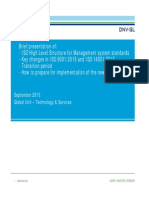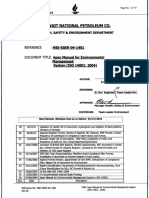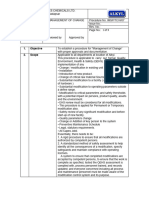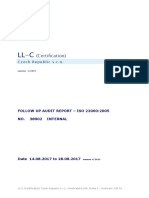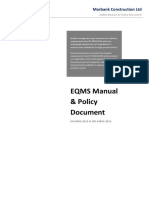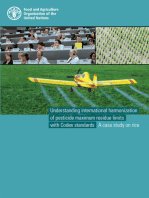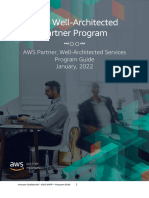IMS Awarness 00
IMS Awarness 00
Uploaded by
RohitSoniCopyright:
Available Formats
IMS Awarness 00
IMS Awarness 00
Uploaded by
RohitSoniCopyright
Available Formats
Share this document
Did you find this document useful?
Is this content inappropriate?
Copyright:
Available Formats
IMS Awarness 00
IMS Awarness 00
Uploaded by
RohitSoniCopyright:
Available Formats
Management certification Kick off meeting
IMS Training : 01/IMS
Awareness program
and
Its Business Impacts
Presented BY :
Mr Rohit Soni
AM-QMS
KEY POINTS OF THE PRESENTATION
History of ISO 9000 .
Why ISO 9001 .
Brief of revision ISO 9001:2015 .
Working model of ISO 9001:2015 .
How ISO /TS 16949 came to existence .
Department Documentation .
Department readiness .
Certification Time line chart .
ISO 9001 History
It all started when the US Military were getting sub-par products from their
suppliers. Then it caught on.
YEAR
STANDARD TITLE
S
1959
MIL-Q-9858
QUALITY PROGRAM REQUIREMENTS
1969
AQAP
NATO ALLIED QUALITY ASSURANCE
PUBLICATIONS
1974
BS 5179
GUIDELINES FOR QUALITY ASSURANCE
1979
BS 5750
SPECIFICATION FOR DESIGN DEVELOPMENT,
PRODUCTION, INSTALLATION AND SERVICING
1987
ISO
9001:1987
Model for quality assurance in design,
development, production, installation, and
servicing
ISO
9002:1987
Model for quality assurance in production,
installation, and servicing
ISO
9003:1987
Model for quality assurance in final inspection
and test
ISO
9001:1994
QUALITY SYSTEMS MODEL FOR QUALITY
1994
ASSURANCE
Why ISO 9001 everywhere
ISO 9000 series :
1
Only ISO 9001 is auditable. The rest serves as references only.
2
ISO 9000
Quality management
systems Fundamental 8
QMS principle and
vocabulary
Essential background for
the proper understanding and
implementation of ISO 9001
1: Customer Focus
2: Leadership
3: Involvement of people
4: Process Approach
5: System approach
6: Continual improvement
7: Factual approach to
decision making
8: Mutually beneficial
supplier relations
3
ISO 9004
ISO 9001
Guidance for organizations
that choose to progress
beyond ISO 9001
requirements to address
a broader range of topics
that can lead to continual
improvement of the
organization's overall
performance
It is a Generic standard
it means that the
same standards can be
applied to any
organization :
Managing for the
sustained success of an
organization
A quality management
approach
Quality management
systemsRequirements
large or small, whatever its
product or service,
in any sector of activity,
and
whether it is a business
enterprise,
a public administration, or
a government department.
International Organization for Standardization
Geneva, Switzerland
International Automotive Task Force
ISO 9000
Covers the Eight Quality
Management Fundamentals
and vocabulary
Generic
system
ISO 9001
TS 16949 :
ISO/TS 16949
Quality
management
systems
Requirements
Automotive Test
specification
set by IATF
Automotive
requirements in
conjunction with
ISO 9001
ISO 9004
Guidelines for performance
improvements of Quality
Management System
Serves as
references
only.
ISO 9001 provides common ground
Quality management systems (QMS) standards for which ISO 9001 is a normative
reference for all kinds of industries
SAE
AS9100C:2009
ISO TS
16949:2009
ISO
13485:2003
QUEST
TL9000
Aerospace
Automotive
Med. devices
Telecom
ISO 9001
1. The clauses are :
1. Scope
2. Normative references
3. Terms and definitions
4. Context of the organization
Understanding the organization and its
context
Needs and requirements
Scope
Management System
5. Leadership
General
Management commitment
Policy
Roles, responsibility and authority
6. Planning
Actions to address risks & opportunities
Objectives and plans to achieve them
7. Support
Resources
Organization Knowledge
Competence & Awareness
Communication
Documented information
8. Operation
Operational planning and control
Control of externally provided processes,
product & services
9. Performance evaluation
Monitoring, measurement, analysis & evaluation
Internal audit
Management review
10. Improvement
Non conformity and corrective action
Continual Improvement
A management system that works on the
performances and growth of the organization
How we can achieve ISO 9001:2015 QMS model ?
1. Scope
2. Normative references
3. Terms and definitions
Clauses No : 4.2 , IS 9001:2015 QMS model , Interested parties Need and expectation
How ISO/TS 16949 came to existence ?
In the past a variety of standards were in use by various automotive companies
around the world. ISO/TS 16949 is designed to eventually replace all of these
standards as the single worldwide automotive sector QMS standard. Previous
standards include the following :
American multinational
QS 9000 (Ford, General Motors, Daimler Chrysler)
French multinational
EAQF 94 (PSA Peugeot, Citron, Renault, FIEV)
German multinational
VDA 6 (Audi, BMW, VW, Daimler Chrysler)
AVSQ 94 (Fiat Auto, IVECO)
European multinational
ISO/TS 16949:2002 was developed by the International Automotive Task Force
(IATF), in conjunction with the International Organization for Standardization (ISO).
The IATF consists of an international group of vehicle manufacturers
BMW Group, DaimlerChrysler, Fiat, Ford Motor Company, General Motors Corporation, PSA
Peugeot Citroen , Renault and Volkswagen, national trade associations AIAG
(America), VDA (Germany), SMMT (UK), ANFIA (Italy) and FIEV (France).
While the Japanese vehicle manufacturers association, JAMA, were also involved in
the development of ISO/TS 16949:2002, they do not formally subscribe to the TS
16949 document as yet or require it of their supply chain.
IMS Documentation and level of submission
Level I
A sample QMS development
Level II
Turtle Diagram
Procedure
Level III
Work Instruction
SOP
Level IV
Forms
Forms
Department involvement & their readiness for QMS development .
Establish the Business operation procedures .
Review existing departmental documents .
(Training , Operating Instruction ,Control plans ,FMEA records, Forms etc. )
Perform Gap analysis .
Establishing KRA for all the departments .
HRD Yearly Training Calendar , Finalize the EHS Legal compliances .
PRD Process Flow , Kanban Implementation .
QA Identifications & Traceability to supplied parts , In process parts .
PE Steps to maintain MTBF(Mean Time Between Failure ),MTTR(Mean Time to Repair) and OEE in Preventive
Maintenance.
ENG - Verification of product and process design and Validating of process on ECN .
PUR New Supplier Development , Vender rating .
PPC Inventory Turnover ratio , Planning vs actual .
MKT- Sales forecast , New business development and Sales turnover .
LOG Monitoring premium fright , Planning vs Dispatch .
NPD New project handling , procurement of martial ,Product verification and validation .
Schedule for IMS development
Citification Time line chart
QMS Master Meeting schedule
You might also like
- Chapter 3. Solution To End-of-Chapter Comprehensive/Spreadsheet ProblemDocument8 pagesChapter 3. Solution To End-of-Chapter Comprehensive/Spreadsheet ProblemBen Harris100% (1)
- Template SAP B1 Pre-Sales Questionnaire V2Document6 pagesTemplate SAP B1 Pre-Sales Questionnaire V2Ndru Dru50% (2)
- DI-AOS-F-01 - Internal Audit NotesDocument10 pagesDI-AOS-F-01 - Internal Audit NotesPearlsgodNo ratings yet
- MRF QEHS ManualDocument22 pagesMRF QEHS ManualAnkurNo ratings yet
- MR-Appointment LetterDocument1 pageMR-Appointment LetterDipjyoti SenNo ratings yet
- QCtool - Charts TrainingDocument65 pagesQCtool - Charts TrainingRaajha MunibathiranNo ratings yet
- Internal and External CommunicationDocument6 pagesInternal and External CommunicationIqah FauziNo ratings yet
- List of DocumentsDocument1 pageList of DocumentsNitin SakpalNo ratings yet
- 2018 Ims Manual Mechanical EngineeringDocument19 pages2018 Ims Manual Mechanical EngineeringMohamed IbrahimNo ratings yet
- HLS and ISO 9001 - ISO 14001 - Key Changes and Transition (September 2015) - tcm8-12652Document18 pagesHLS and ISO 9001 - ISO 14001 - Key Changes and Transition (September 2015) - tcm8-12652KumaravelNo ratings yet
- IMSP 7.1 ResourcesDocument6 pagesIMSP 7.1 ResourcesArchiford NdhlovuNo ratings yet
- MRM MinutesDocument10 pagesMRM Minutesisooffice38000No ratings yet
- ISO 14001 Competence Awareness and Training ProcedureDocument31 pagesISO 14001 Competence Awareness and Training Proceduresadiquehr1No ratings yet
- Inplant Qulaity Problem Analysis & Countermeasure Report (QPCR)Document1 pageInplant Qulaity Problem Analysis & Countermeasure Report (QPCR)Pinkoo QualityNo ratings yet
- The Balanced Scorecard: ISO 9001 - ISO/TS 16949 - AS9100CDocument1 pageThe Balanced Scorecard: ISO 9001 - ISO/TS 16949 - AS9100CAnkur DhirNo ratings yet
- Appendix 10 Waste Matrix Attachment A 092203Document14 pagesAppendix 10 Waste Matrix Attachment A 092203droffilcz27No ratings yet
- IMS Internal Audit Case Studies Comprising ISO 9001,14001 and 45001Document13 pagesIMS Internal Audit Case Studies Comprising ISO 9001,14001 and 45001Justin B NickafNo ratings yet
- ISO 9001:2015 Quality Manual ContentsDocument2 pagesISO 9001:2015 Quality Manual ContentsTatiana RiloNo ratings yet
- Apex - Manual For EMS (ISO 140012007)Document47 pagesApex - Manual For EMS (ISO 140012007)Suresh Babu V.M.100% (2)
- IMSaudit ResponsibilityDocument4 pagesIMSaudit ResponsibilityDebabrata GhoshNo ratings yet
- Form - Management Review Meeting MinutesDocument6 pagesForm - Management Review Meeting Minutesshahrilzainul77100% (1)
- Environmental Register Evaluation of Possible Emergencies (FMEA)Document4 pagesEnvironmental Register Evaluation of Possible Emergencies (FMEA)Pandu BirumakovelaNo ratings yet
- ISO 9001:2000 IN A NUTSHELL (First Revision)Document5 pagesISO 9001:2000 IN A NUTSHELL (First Revision)nallasivam v100% (1)
- Training ProgramsDocument1 pageTraining Programshunain zafarNo ratings yet
- Escalation Level E 0: Escalation Process - Status ReportDocument1 pageEscalation Level E 0: Escalation Process - Status ReportSudhagarNo ratings yet
- EF-EP04-01 ProcedureDocument2 pagesEF-EP04-01 ProcedureVasanth PrabhuNo ratings yet
- Trees Diagram System of Iso/Ts 14969: 2009Document8 pagesTrees Diagram System of Iso/Ts 14969: 2009AyuNo ratings yet
- IT Procedures Manual TemplateDocument4 pagesIT Procedures Manual TemplateYiWanNo ratings yet
- TS Quality ManualDocument70 pagesTS Quality ManualPedro SousaNo ratings yet
- EMS-80. Management Review MeetingDocument8 pagesEMS-80. Management Review MeetingAmirulNo ratings yet
- CD05 UoG Legal RegisterDocument20 pagesCD05 UoG Legal RegisterKingsley AhanonuNo ratings yet
- IMS Audit CriteriaDocument1 pageIMS Audit CriteriaVenkateshNo ratings yet
- List of Documents of External OriginDocument3 pagesList of Documents of External Originmalli55No ratings yet
- TRG Iso 14001Document57 pagesTRG Iso 14001Sunil AroraNo ratings yet
- Context & Strategy Analysis: ISO 9001:2015 QMSDocument3 pagesContext & Strategy Analysis: ISO 9001:2015 QMSshailendra singhNo ratings yet
- ISO 45001 Clause: RequirementDocument2 pagesISO 45001 Clause: RequirementAarya Mishra TiwariNo ratings yet
- Chain of Custody Certification: FSC-STD-40-004 V3-1 ENDocument52 pagesChain of Custody Certification: FSC-STD-40-004 V3-1 ENIsabel MarquesNo ratings yet
- IMSPTCH07-revised On 13.04.2023Document9 pagesIMSPTCH07-revised On 13.04.2023madhuramfoods.chiralaNo ratings yet
- Procedure 19 Non-Conformances, Investigation and Corrective - Preventative ActionsDocument3 pagesProcedure 19 Non-Conformances, Investigation and Corrective - Preventative ActionsLemuel PajarillagaNo ratings yet
- Facility Health, Safety and Environmental Management (Hse)Document2 pagesFacility Health, Safety and Environmental Management (Hse)Syahirah NazriNo ratings yet
- ICM Certification (P) LTD.: STANDARD: - ISO 9001: 2015 Audit ReportDocument18 pagesICM Certification (P) LTD.: STANDARD: - ISO 9001: 2015 Audit ReportRohit Attri100% (1)
- Process Clause MatrixDocument6 pagesProcess Clause Matrixmuhammad kamranNo ratings yet
- F45 Follow Up Audit Report ISO 22000 EnglishDocument13 pagesF45 Follow Up Audit Report ISO 22000 Englishivan stojaovNo ratings yet
- Fh-Hra-05 Training Feedback FormDocument2 pagesFh-Hra-05 Training Feedback FormKarthi ThiyagarajanNo ratings yet
- PUR-R-01 External Provider Registration FormDocument3 pagesPUR-R-01 External Provider Registration FormManigandan RNo ratings yet
- Nonconformity ReportDocument3 pagesNonconformity ReportkumaravNo ratings yet
- Fm-112 Context of OrganizationDocument1 pageFm-112 Context of OrganizationAnkur DhirNo ratings yet
- $ Eqms02 Manual & Policy Document v1 20170911 PDFDocument48 pages$ Eqms02 Manual & Policy Document v1 20170911 PDFAles esaamNo ratings yet
- External Provider Registration FormDocument2 pagesExternal Provider Registration Formpulkit gargNo ratings yet
- Win More Tenders With ISO Management SystemsDocument3 pagesWin More Tenders With ISO Management SystemsDavid100% (2)
- Status of ISO 9000 Family of StandardsDocument4 pagesStatus of ISO 9000 Family of StandardsRajan SteeveNo ratings yet
- RP SP F 01 System Review MeetingDocument3 pagesRP SP F 01 System Review MeetingAnonymous SAWWr9Y3lyNo ratings yet
- EHS Objectives FY (20-21)Document3 pagesEHS Objectives FY (20-21)Deepak DasNo ratings yet
- QSP 06 - Preventive ActionDocument5 pagesQSP 06 - Preventive ActionVivek VNo ratings yet
- 4.3 - B - 7 - Procedure For OHS Management ProgrammeDocument3 pages4.3 - B - 7 - Procedure For OHS Management ProgrammeSASIKUMAR SNo ratings yet
- Draft Site Operating Manual - HUL HO Mumbai (For Joint Discussion With UL Team)Document1 pageDraft Site Operating Manual - HUL HO Mumbai (For Joint Discussion With UL Team)Subhranshu ChakrabortyNo ratings yet
- Uncontrolled Copy: I. Overview and OrganizationDocument48 pagesUncontrolled Copy: I. Overview and OrganizationGib ArNo ratings yet
- ISO 28000 A Complete Guide - 2019 EditionFrom EverandISO 28000 A Complete Guide - 2019 EditionRating: 4 out of 5 stars4/5 (1)
- Understanding International Harmonization of Pesticide Maximum Residue Limits with Codex Standards: A Case Study on RiceFrom EverandUnderstanding International Harmonization of Pesticide Maximum Residue Limits with Codex Standards: A Case Study on RiceNo ratings yet
- 2.1 Understanding REACH: How Does REACH Work?Document3 pages2.1 Understanding REACH: How Does REACH Work?xixixoxoNo ratings yet
- Explore Project Management RolesDocument4 pagesExplore Project Management RolesJanet NgôNo ratings yet
- Revised Minimum Recommended Scale of Fees For The Professional Assignments Done by The Chartered AccountantsDocument30 pagesRevised Minimum Recommended Scale of Fees For The Professional Assignments Done by The Chartered AccountantsGAURAV GUPTANo ratings yet
- EconomicsDocument7 pagesEconomicsJelo Matt CamoronganNo ratings yet
- Imad A. Moosa - Fintech - A Revolution or A Transitory Hype - Edward Elgar Publishing (2022)Document253 pagesImad A. Moosa - Fintech - A Revolution or A Transitory Hype - Edward Elgar Publishing (2022)Ibrahim KhatatbehNo ratings yet
- Spergeon Aaiclas ReportDocument36 pagesSpergeon Aaiclas ReportspergeonNo ratings yet
- Kotler Mm14 Ch07 DPPTDocument27 pagesKotler Mm14 Ch07 DPPTFidelisAthenaNo ratings yet
- Meghna Petroleum Limited: Chart of AccountsDocument21 pagesMeghna Petroleum Limited: Chart of AccountsAbu Shahadat Muhammad SayeemNo ratings yet
- Gantt Chart Towards ISO 14001 & 45001 (2023 09 11)Document19 pagesGantt Chart Towards ISO 14001 & 45001 (2023 09 11)Ilmam MazlanNo ratings yet
- Vodafone HutchDocument12 pagesVodafone Hutchkushalnadekar0% (1)
- C11 Social EntrepreneurshipDocument28 pagesC11 Social Entrepreneurshiphuzailinsyawana100% (1)
- Completing The Accounting Cycle: © 2009 The Mcgraw-Hill Companies, Inc., All Rights ReservedDocument57 pagesCompleting The Accounting Cycle: © 2009 The Mcgraw-Hill Companies, Inc., All Rights ReservedPham Thi Hoa (K14 DN)No ratings yet
- Union Bank 1Document12 pagesUnion Bank 1bindu mathaiNo ratings yet
- Operations Management: Chapter 8 - Location StrategiesDocument46 pagesOperations Management: Chapter 8 - Location StrategiesFatimah KhanNo ratings yet
- Week 8 Class ExercisesDocument3 pagesWeek 8 Class ExercisesChinhoong Ong100% (1)
- Mergers and AcquisitionDocument60 pagesMergers and AcquisitionVarsha JaisinghaniNo ratings yet
- Cms TrendsDocument18 pagesCms TrendsSumeetMahajanNo ratings yet
- McDonald Value Propositions PDFDocument14 pagesMcDonald Value Propositions PDFMKMKANDY100% (1)
- AI in Organization A Helping Hand of HRDocument9 pagesAI in Organization A Helping Hand of HRSAVITANo ratings yet
- Assessement Test 6 - Change of PSR - Docx - 1661182024584Document2 pagesAssessement Test 6 - Change of PSR - Docx - 1661182024584Shreya PushkarnaNo ratings yet
- M o D U L e - 2 - Investment DecisionDocument70 pagesM o D U L e - 2 - Investment DecisionKeyur PopatNo ratings yet
- ASCP - LMU - Advanced SyllabusDocument3 pagesASCP - LMU - Advanced SyllabusChanezNo ratings yet
- AWS Well-Architected Partner Program GuideDocument7 pagesAWS Well-Architected Partner Program GuideHAZEM H. ALI HASSAN REWIHANo ratings yet
- Hang Seng Bank MTDocument1 pageHang Seng Bank MTJacky WongNo ratings yet
- Capítulo 10, Chopra - Inventario de Ciclo en La Cadena de SuministroDocument44 pagesCapítulo 10, Chopra - Inventario de Ciclo en La Cadena de SuministroBräyän MüñöszNo ratings yet
- CH 07Document16 pagesCH 07MonaIbrheemNo ratings yet
- Security Analysis AssignDocument23 pagesSecurity Analysis AssignDerickMwansaNo ratings yet
- Capital Budgeting and Estimating Cash FlowsDocument34 pagesCapital Budgeting and Estimating Cash Flowstjsami0% (1)









